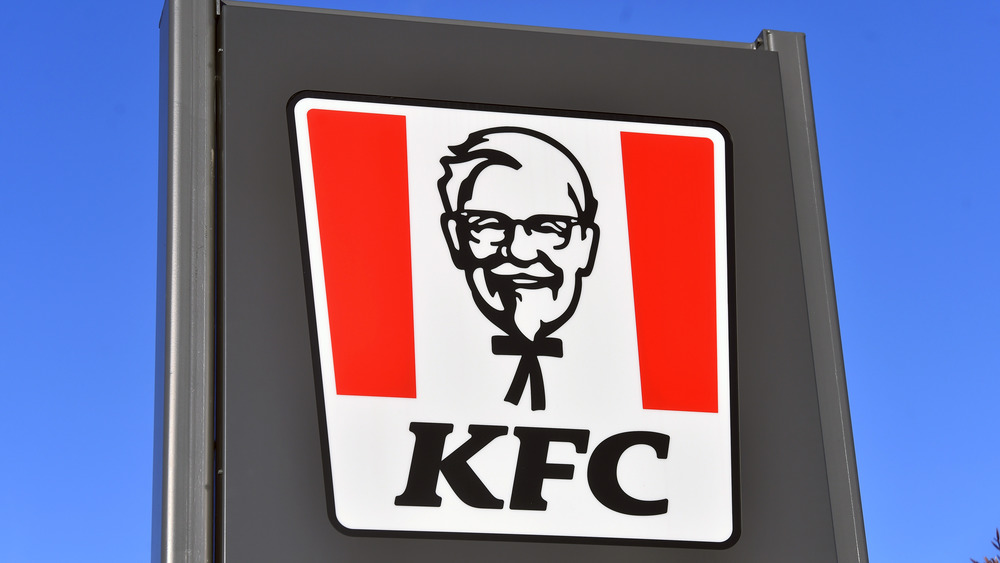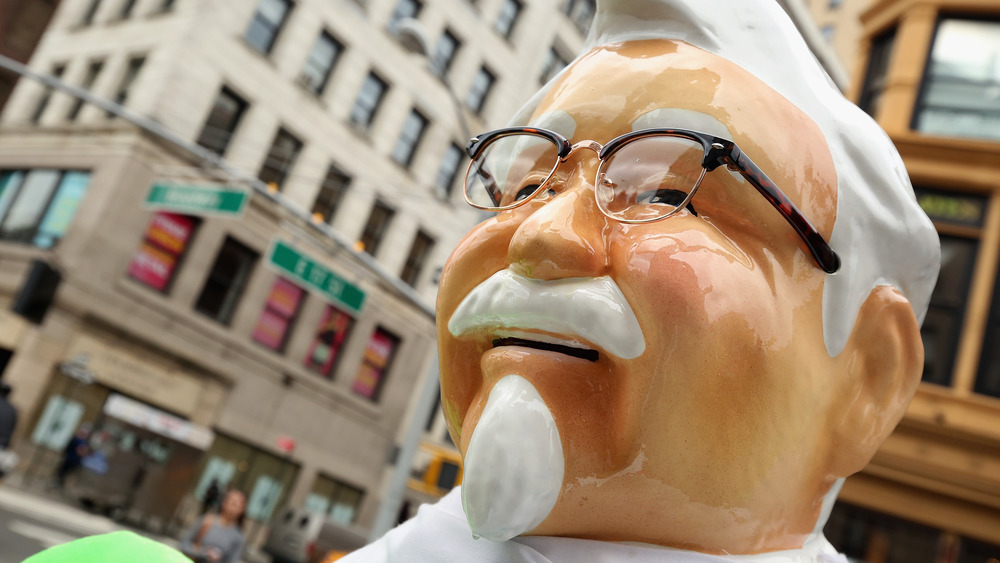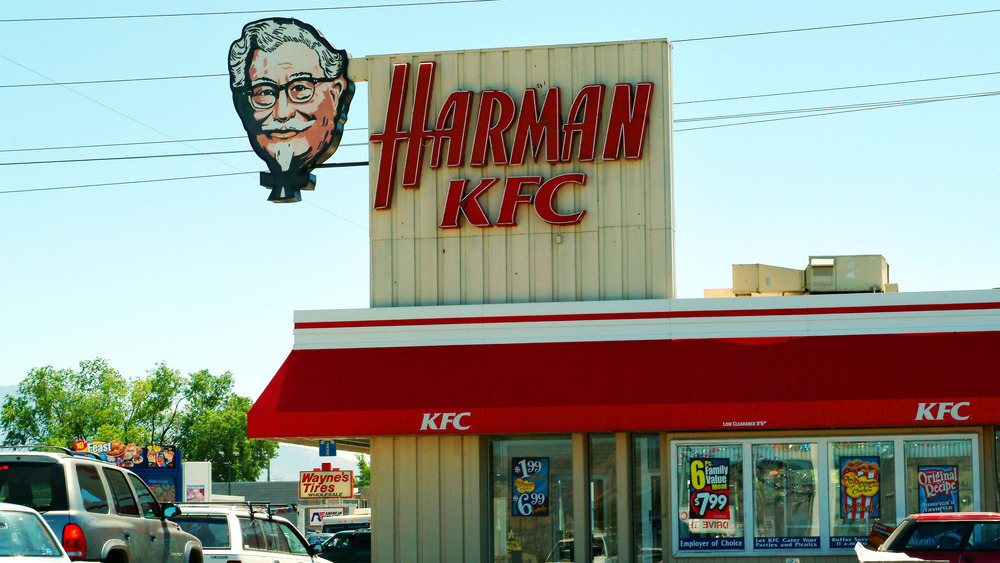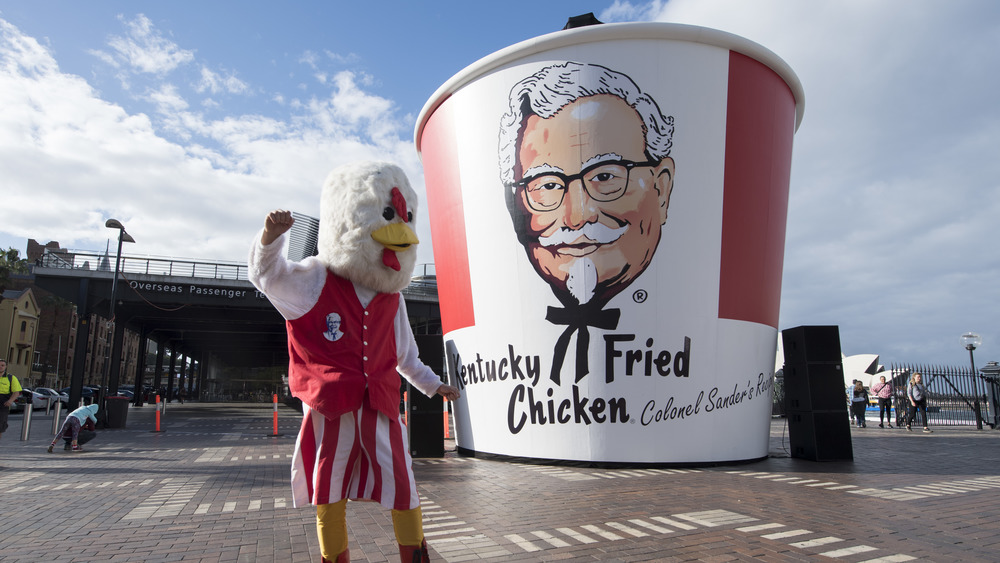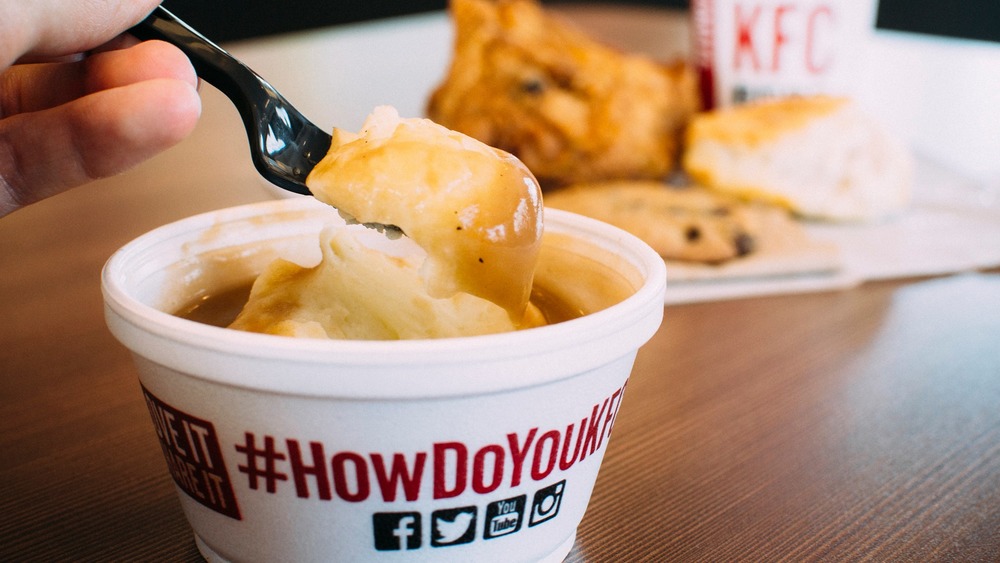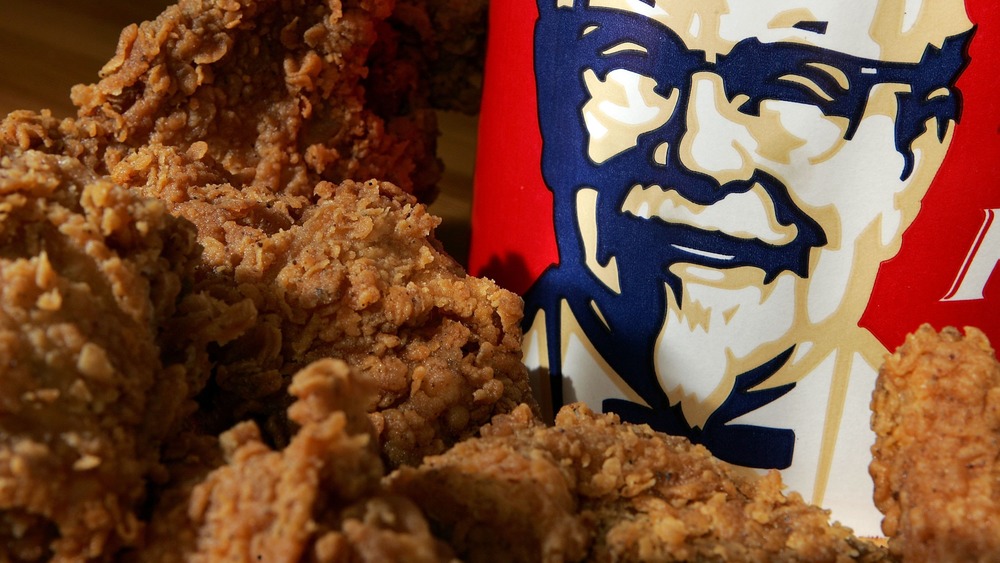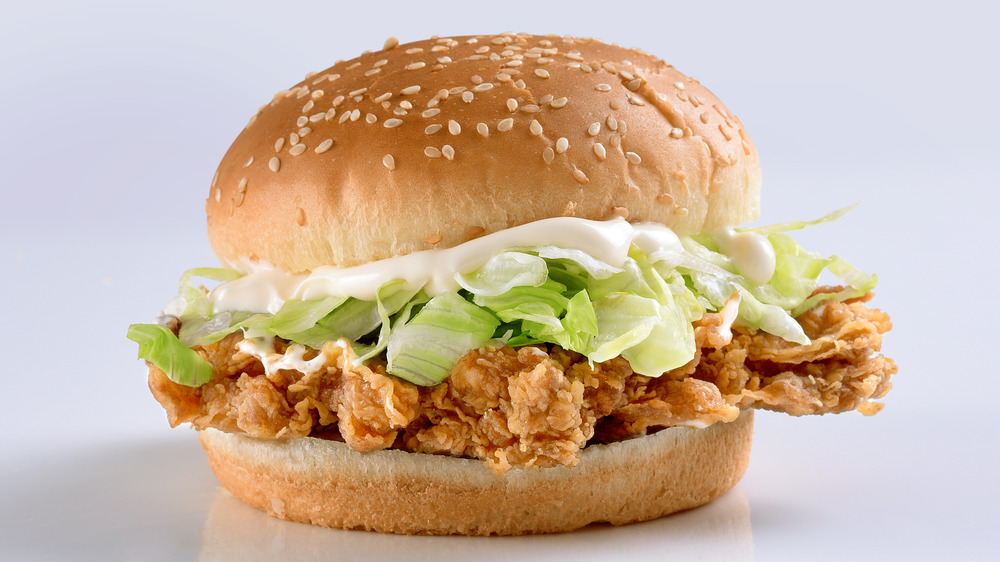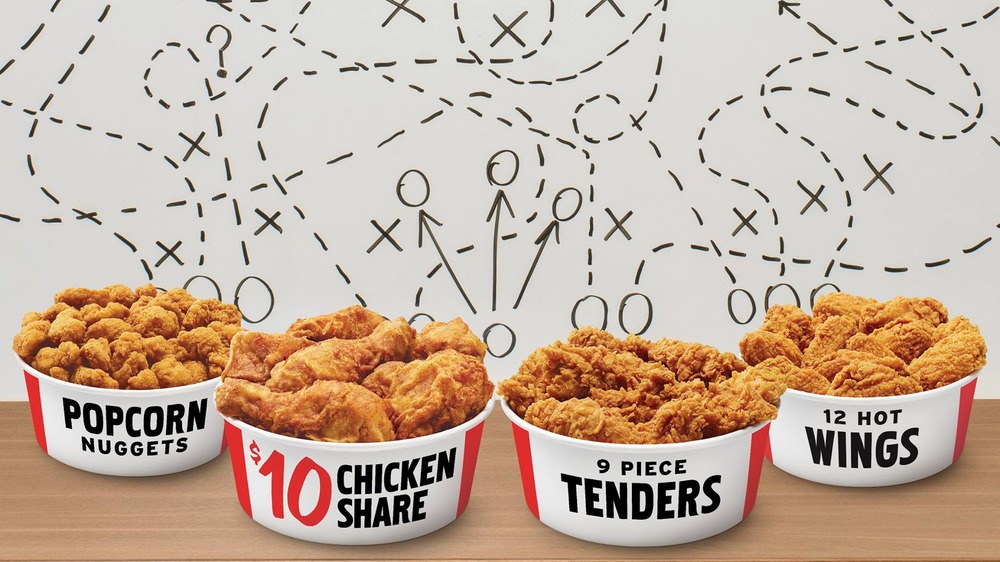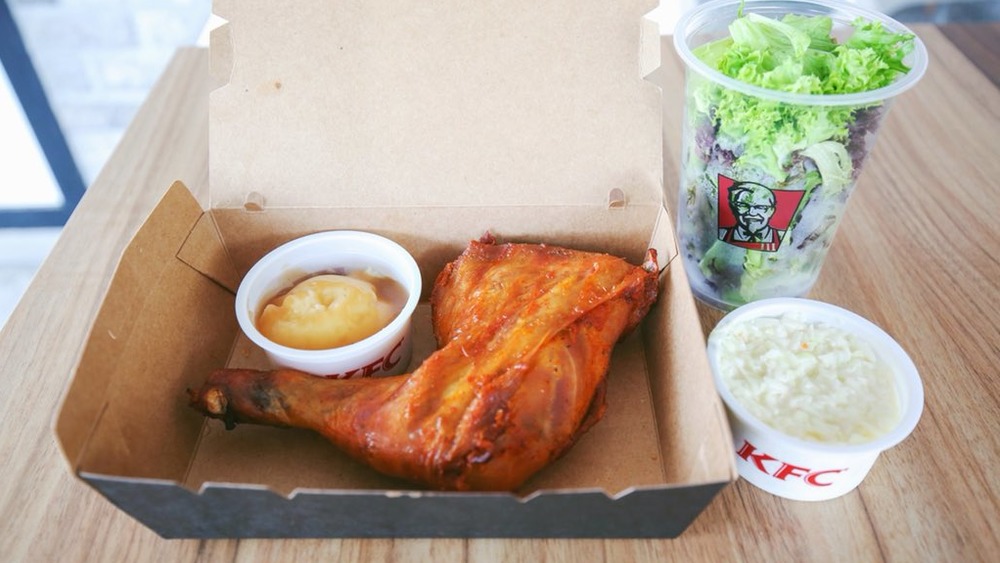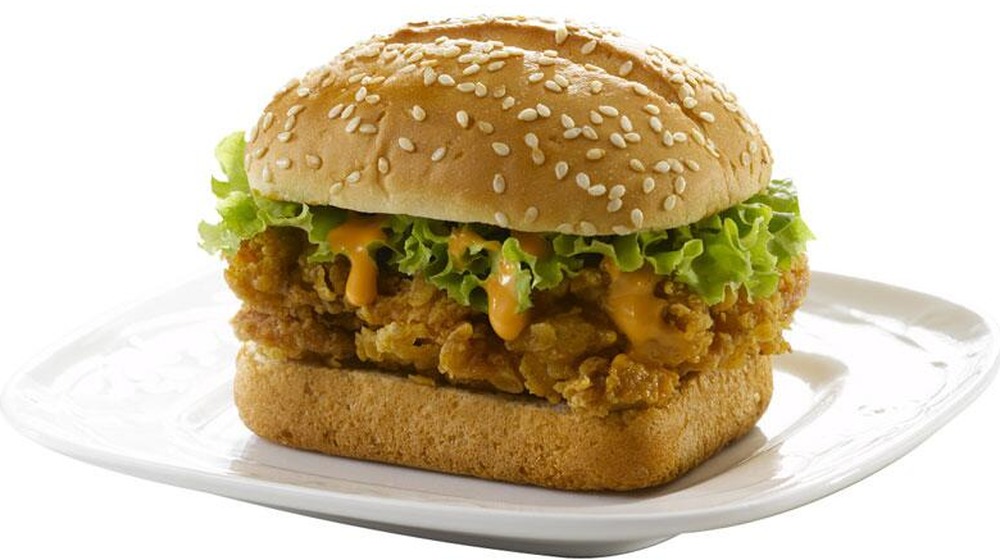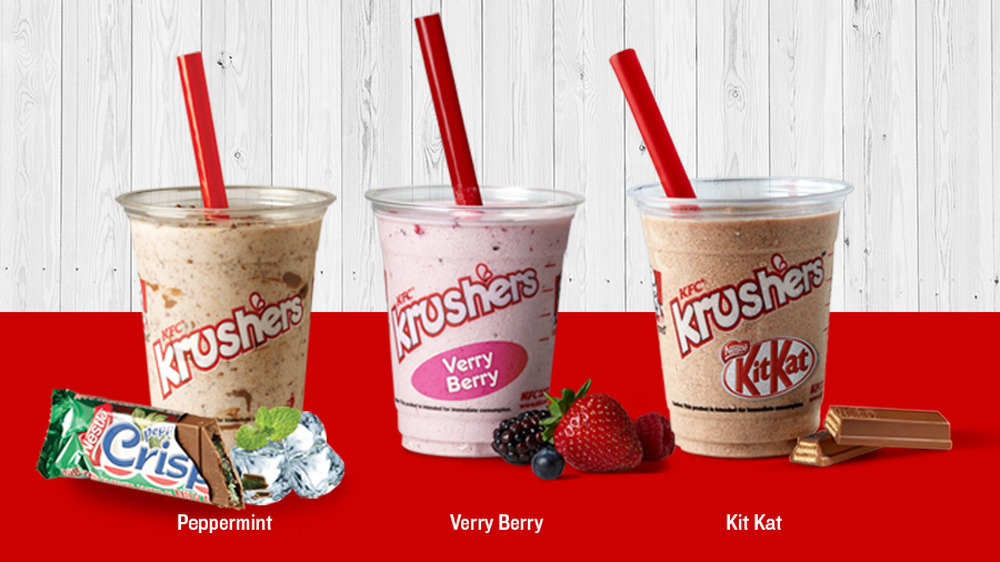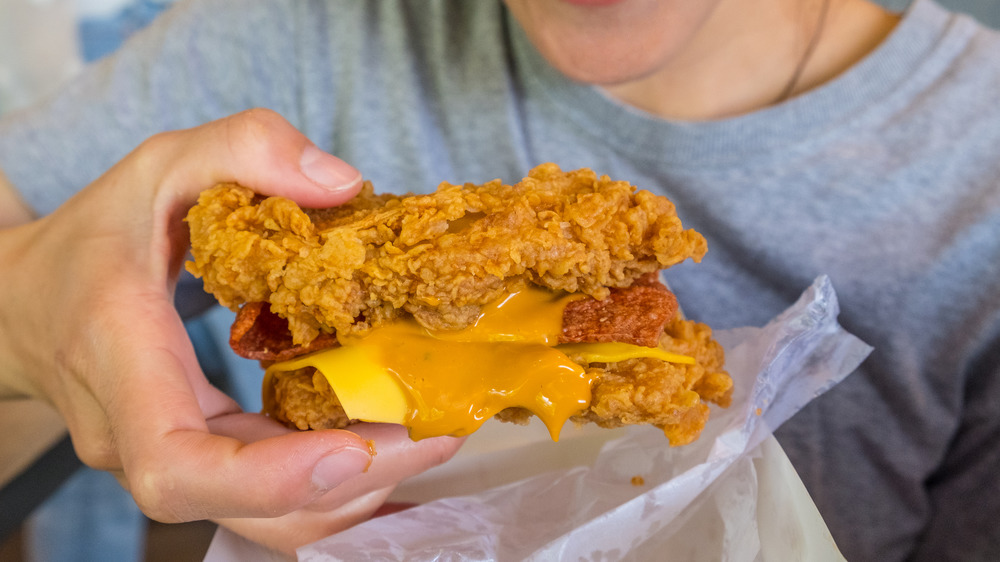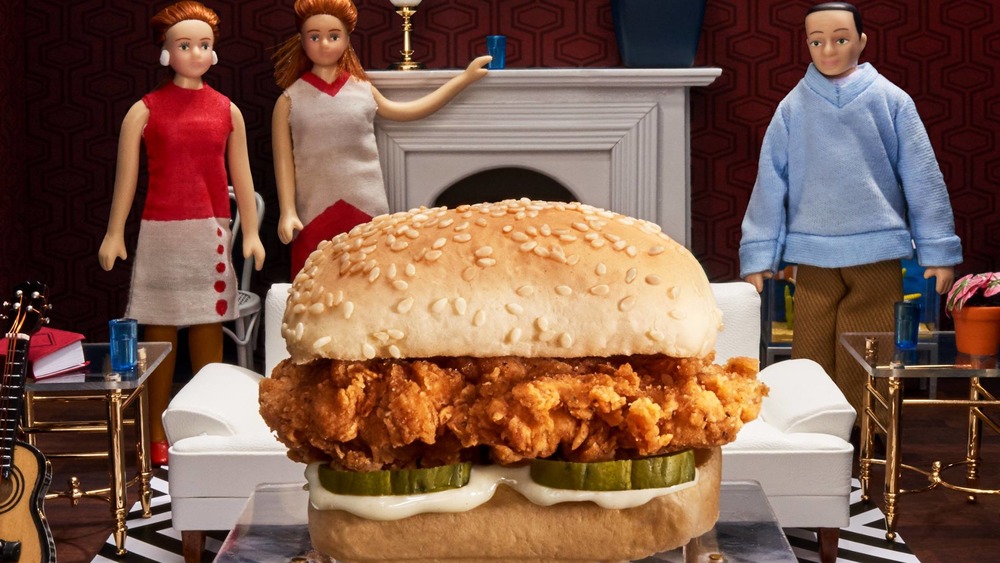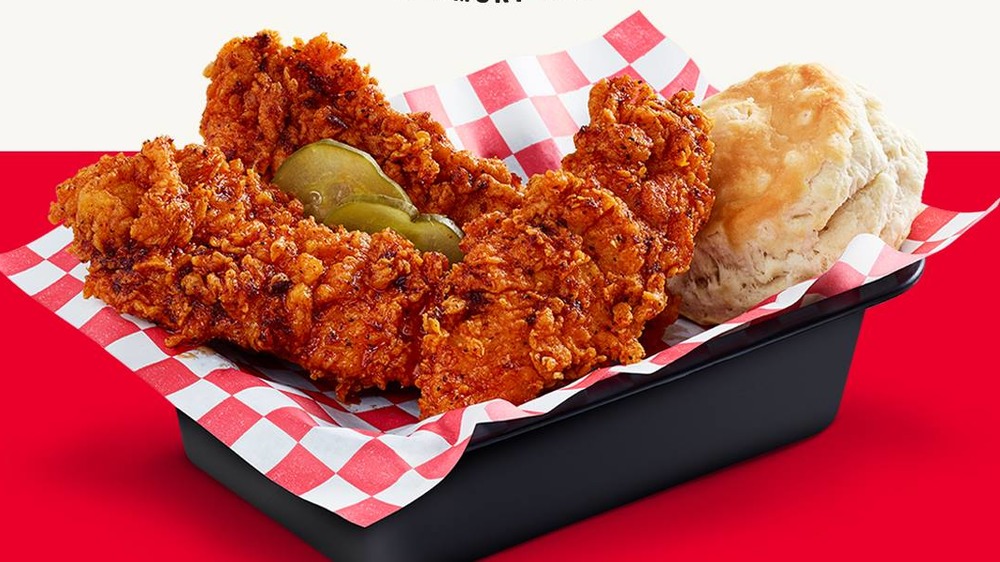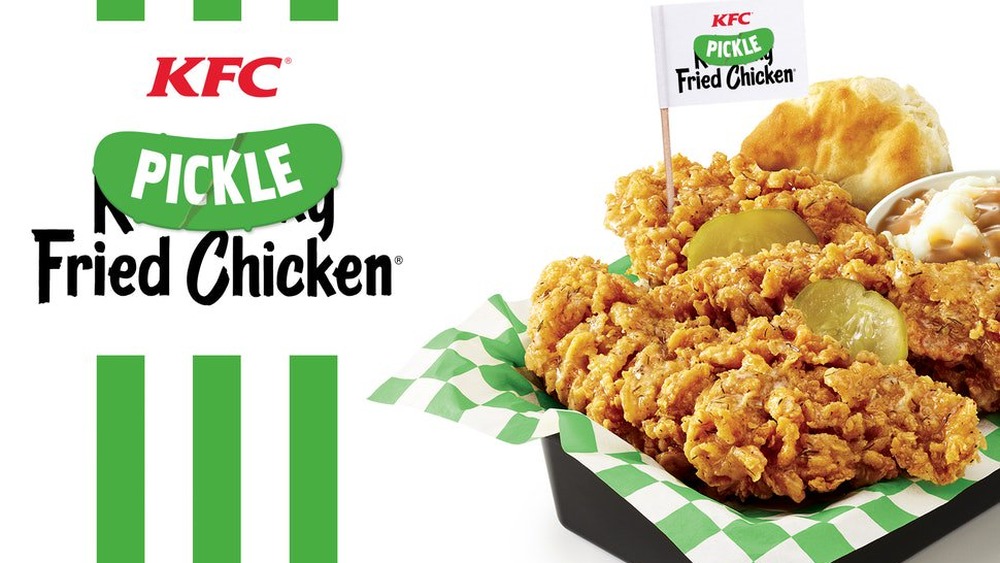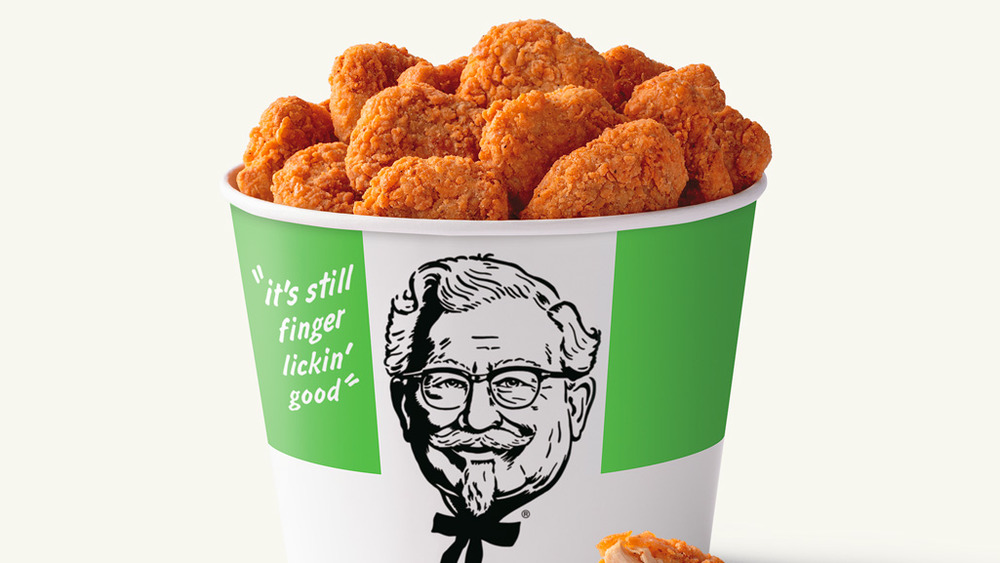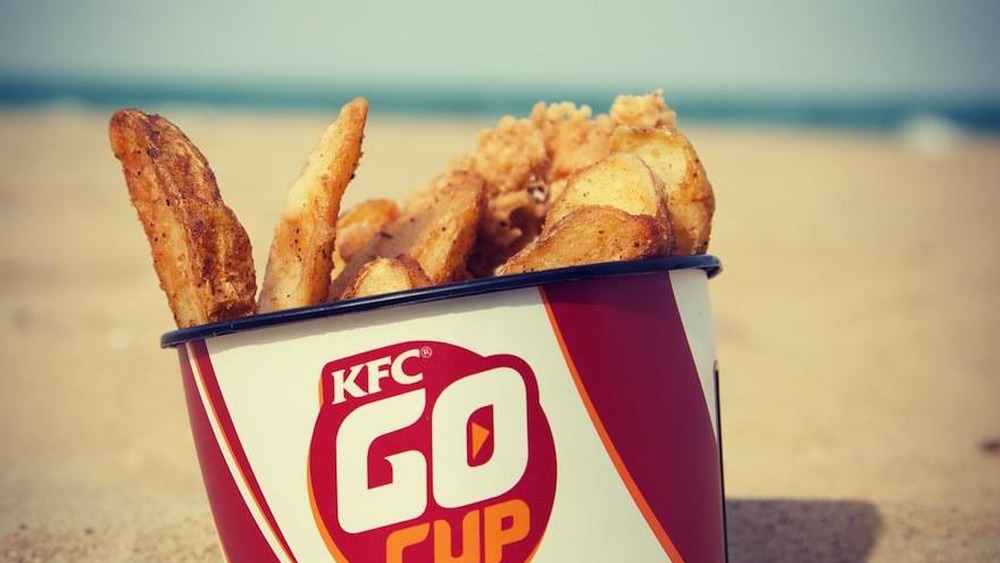What KFC's Menu Looked Like The Year You Were Born
Love 'em or hate 'em, you can't deny the expansive reach of Kentucky Fried Chicken, otherwise known as KFC (and, possibly to some young readers, KFC only thanks to one marketing ploy in the 1990s). While KFC got its humble start in the tiny, tiny town of Corbin, Kentucky, the restaurant's global influence is mammoth, made possible in part due to the famous (or possibly infamous, depending on your view) Colonel Sanders' tenacity and simple dedication to good fried chicken. Now, there are more than 24,000 KFC restaurants in more than 145 countries, with a new KFC restaurant opening, on average, every six hours. KFC employs 800,000-plus team members and two-thirds of the world's KFC restaurants are yet to be built.
The KFC menu has changed considerably over the years and differs equally depending on where in the world you live. Still, you can find the famed red and white bucket of KFC original fried chicken, with its secret 11 herbs and spices, at every eatery, with the bucket menu item representing 35 percent of the chain's global sales. Then, depending on where you are, you might find spicy chicken sandwiches, fish sandwiches, or even Blizzard-like desserts called "Krushers."
Learn more about these significant KFC menu items and more, with a look at how KFC's menu has changed over the last near-century of its existence.
1930–1951: Colonel Sanders gets a slow start in Central Kentucky
The story of KFC is, at least at the beginning, also the story of Colonel Sanders. Born in 1890, Sanders got a late start in life, working all kinds of jobs before eventually taking over a service station in Kentucky, at the age of 40 in 1930. Things were not exactly easy over the years, but eventually, Sanders grew a name for himself thanks to the fried chicken he would offer at said service station. The location becomes the OG KFC, then named Sanders Court & Cafe, and over time grew into a roadside attraction with dine-in seating for 142 patrons.
The menu focused on fried chicken (of course) and, over the next decade, Sanders continues to perfect his recipe of 11 herbs and spices that season the Original Recipe variant of fried chicken that KFC still offers today. However, that wasn't the only thing that made Sanders' chicken stand out; he also had a unique way of frying his poultry, which guaranteed a consistent fry every time, while also quickening the frying process, so workers could churn out more chicken to more patrons more quickly.
1952–1956: Kentucky Fried Chicken goes to Utah
Once Colonel Sanders had finally hit on his path to success in life, at the ripe old age of 62, he decided to take his restaurant idea on the road and opened the first KFC franchise location. But rather than offering the franchise opportunity to his friends and neighbors in nearby Kentucky locales, he headed a little further afield — going to Utah to open the first KFC franchise location in Salt Lake City.
The first franchise Kentucky Fried Chicken menu wasn't that different from the menus you'll see today. Somewhat limited, the first menus included boxes of fried chicken in various quantities alongside the still-popular sides of chicken gravy, mashed potatoes, and coleslaw. Instead of the iconic KFC biscuits that you'll find on the menu today, though, the older combos featured hot rolls and honey instead. A "thrift box" of nine chicken pieces to feed three to four people was just $2.25, while the "regular box" with three pieces of chicken, whipped potatoes, gravy, a hot roll, and coleslaw came out to just $1.10.
1957–1963: An iconic piece of KFC packaging appears
It was just shortly later that KFC formalized a menu item that would become an iconic piece of Americana and recognizable to diners all over the world: the KFC Bucket. Though KFC had technically sold buckets of chicken before, the official red and white take-out bucket with 15 pieces of chicken, hot rolls, and a pint of gravy was a hit when introduced bearing Colonel Sander's wizened and grinning visage and the Kentucky Fried Chicken name.
The bucket was marketed as a solution for busy housewives in the late '50s and early '60s. All they needed to do was pick up a bucket of chicken from KFC and then add a salad or vegetable to the meal for a complete, balanced dinner for the average family. Housewives could get out of the kitchen for a change, while still fulfilling their maternal duties, and everyone enjoyed some "finger lickin' good" fried chicken in the process.
1964–1969: Colonel Sanders cashes out — and the gravy at KFC suffers
It didn't take long at all for KFC to grow from that single franchise location in Salt Lake City into a North American sensation. By 1964, there were hundreds of KFC locations across both the United States and Canada and, after a lot of wooing, Colonel Sanders decided to cash out and sell the company for a whopping $2 million and an annual salary. Unfortunately, the deal didn't make him happy, and his displeasure all came down to menu changes (via The New Yorker).
Following Sanders' departure, the new owners decided to change the chicken gravy recipe, opting for a recipe that was easier to make for the average employee, and one that was a lot quicker to make, too. One executive said at the time, "Let's face it, the Colonel's gravy was fantastic, but you had to be a Rhodes Scholar to cook it. It involved too much time, it left too much room for human error, and it was too expensive."
Colonel Sanders became infamous for visiting KFC locations around the United States and sampling the gravy, letting franchisees know exactly what he thought about their work. While he personally aimed for gravy so good that "it'll make you throw away the durn chicken and just eat the gravy," he would frequently pronounce the gravy at the franchise locations as too runny, too glue-y, and just plain bad.
1970–1979: Sanders colorfully describes KFC's new, 1970s menu items
The 1970s saw a continual commitment to the menu items that made KFC famous in the first place, with a few additions and expansions. You could still get the regular dinner box on the early 1970s menu, with the same three pieces of chicken, coleslaw, mashed potatoes, gravy, and a hot roll, but the price had gone up from $1.10 to $1.35. In addition to the family bucket, KFC also introduced the Barrel in the early 1970s, which offered 21 pieces of chicken only, for serving seven to ten people; it was labeled as "perfect for parties." In the late 1970s, KFC changed the name of the Barrel to the Bumper Box. By this time, you could also find new sides on the menu such as fruit salad, along with the standard sides that had been a part of the menu since the 1950s, including mixed bean salad and potato salad.
In 1974, KFC also introduced a new product — a variant on the original fried chicken that you can still find today: extra crispy chicken. (Colonel Sanders, unsurprisingly, did not care for this menu change either, calling the new menu item "a d*** fried dough ball put on top of some chicken.") At this point, to avoid confusion, KFC officially labeled the previous chicken option "Original Recipe," to differentiate between the two.
1980–1989: Chicken sandwiches are the next frontier for KFC
In the 1980s, KFC entered into previously uncharted territory: chicken sandwiches. The Chicken Little (which reappeared on menus in 2012) was introduced as a very straightforward chicken sandwich. Small, square, and looking kind of like a slider, the Chicken Little sandwich was as basic as it gets: chicken on bread with mayonnaise. And people loved them.
Meanwhile, across foreign borders, KFC was working on a different kind of chicken sandwich, something a little spicier and bolder: the Zinger. First introduced in Trinidad and Tobago in 1984, the Zinger features a spicy fried chicken patty, lettuce, mayonnaise, and a sesame seed bun. Although the menu item wasn't released in the United States until 2017, the sandwich experienced rapid success all around the rest of the world. According to KFC, as of 2017, the Zinger was served in more than 120 countries; more Zingers are sold in the United Kingdom, India, and Australia than anywhere else; and Australia alone sells more than 22 million Zingers each year.
1990–1992: KFC wings and popcorn chicken leave a bit to be desired
In the early 1990s, KFC took the brand's exploration of other forms and fashions of fried chicken further — not to mention, in 1990, Kentucky Fried Chicken decided to go with the KFC name only, in an effort to avoid the poor stigma surrounding the word "fried." So, right after, rather than simply placing fried chicken on a bun and calling it a day, the brand decided to go into even more unfamiliar waters, with hot wings in 1991 and popcorn chicken in 1992.
While, for today's diners, the KFC hot wings are a little more than a blip on the restaurant's radar, at the time, wings were making an appearance at all kinds of fast-food locations, so it just made sense for KFC, with all of its chicken expertise, to get in on the game. For example, in 1990, McDonald's was selling Mighty Wings at select locations (before bringing them back nationwide in 2014) and then Domino's Pizza brought wings to its menu in 1994.
The popcorn chicken received a little more attention when it arrived on the scene in 1992, but the reviews weren't always favorable. As one reviewer for the Orlando Sentinel noted, "that whirring noise you hear is the Colonel spinning in his grave" and "despite its name, there is no popcorn involved and, judging from the portion I sampled, not much chicken, either."
1993–1994: The KFC chicken experiments continue
In 1993, KFC rolled out a product called "Colonel's Rotisserie Gold," a roasted chicken that was designed to compete with similar products from Roy Rogers, Boston Market (formerly Boston Chicken), and even McDonald's. A 1993 Chicago Tribune article reported that, in test markets with ad support, Rotisserie Gold improved KFC's sales by 20 to 30 percent at individual outlets.
The Rotisserie Gold option was available in a quarter, half, or whole chicken size, and accompanied by some new sides like garden rice, pasta salad, and a corn muffin. One AP article quoted the KFC U.S. president at the time as saying, "KFC is clearly trying to contemporize the brand. The consumers demanded it. They said they would come more frequently with non-fried chicken."
And while Rotisserie Gold didn't last, KFC did bring grilled chicken back on a wider basis later, recognizing the continual modern desire for a non-fried chicken product.
1995–2004: KFC pairs up with Campbell's Soup and Pepperidge Farm for a new product
The chicken experiments slowed down in the late 1990s and early 2000s, but KFC did manage to add one interesting new menu item to its offerings that's along the same lines as its chicken experimentation of the early '90s. The KFC chicken pot pie was intended as a reinvention of an American classic, according to a press release. The 13-ounce pot pie included 2.5 ounces of chicken smothered in a sauce developed in partnership with Campbell's Soup Company (ingredients included cream, chicken stock, and seasonings). Other ingredients included white potatoes, peas, and carrots, and it was all topped with a pie crust developed in partnership with Pepperidge Farms.
KFC really rolled out the red carpet for the chicken pot pie's arrival, with a huge product launch event in New York City that featured a Guinness World Record largest pot pie (at 22,100 pounds) and even some kick-dancing carrots and peas — all overseen by the world's largest chicken hot air balloon, measuring 75 feet in length.
2005–2008: The most successful product launch in KFC history
An international issue helped put this new item on the menu. In 2005, the world was dealing with the avian flu scare, which, somewhat unfairly, gave a bit of a bad name to our favorite poultry friends. Poor sales on KFC's part resulted.
So, KFC launched its Snacker sandwich in March 2005. Very similar to KFC's previous Chicken Little sandwich, which was more slider-like in nature, the Snacker was an extra crispy chicken strip with lettuce and pepper mayonnaise on a sesame seed bun (so a little more like the Zinger, only without the spicy chicken). But the Snacker's real appeal may have come from its price: just $0.99 per sandwich.
The launch of the Snacker came just at the right time and was one of the most successful product launches in KFC history. Some KFC locations reported sales of as much as 1,000 sandwiches per week, with 100 million Snackers sold in the United States in just six months.
"The KFC Snacker is a huge hit with consumers because it satisfies their need for a high-quality, affordable, portable chicken sandwich," said KFC's EVP of marketing at the time. "The KFC Snacker is an example of how KFC is becoming more relevant to today's consumers. We are appealing to individuals as well as families with products that are in tune with their lifestyle needs."
2009: KFC does drinks
In 2009, KFC launched another hit item, though this option was focused on the international market. Krushers is a line of drinks, both dairy and fruit-based, with add-in toppings. For example, Krushers available in India include the Strawberry Storm, which features crunchy strawberries in a creamy yogurt and dairy slush, and the Chocopeanut Bolt, with chocolate cookies, peanut butter, and syrup all blended together.
Originally introduced in Australia (though no longer available in that market), the Krushers launch was the largest beverage launch in Yum! Brands, Inc. history. In some international KFC locations, there are now even in-store Krushers experiences, with bars where you can build your own Krushers beverages. That's not surprising considering the Krushers product has developed a huge following around the world, with dedicated Facebook pages, petitions to bring it back to previous markets, and even memes. When KFC removed Krushers from Australia, regional publications called it "the end of an era."
2010: KFC doubles down on its chicken sandwich game
For the start of a new decade, KFC decided to take things to an entirely new level when it came to its chicken sandwiches. After a "wildly" successful market test, KFC launched the Double Down, a chicken sandwich made with no bun. Instead, the sandwich is two thick chicken filets (either fried or grilled), holding together two pieces of bacon, two melted slices of cheese, and a sauce. Of course, while some diners were thrilled with the idea, evidenced by the launch's success, many speculated over the sandwich's nutritional value (after all, it does seem like an awful lot of fried chicken). KFC was quick to refute claims of inflated caloric content, however, and pointed out that with its 540 calories, the Double Down was similar in calorie count to many fast food burgers.
Meanwhile, in 2010, KFC decided to permanently add its Colonel's Catch fish sandwich to its menu. The sandwich, made of Alaskan Pollock and topped with tartar sauce and a sesame seed bun, was previously only available to diners during Lent in select markets.
2012: KFC brings back a cult classic ... sort of
In 2012, KFC decided to bring back a 1980s favorite, the Chicken Little sandwich, with a few adjustments that, unfortunately for the brand, weren't that well received, especially when many diners still had the KFC Snacker sandwich in the back of their minds.
Slightly more expensive than the $0.99 Snackers, at $1.29 each, the new Chicken Littles weren't quite so slider-esque as the previous Chicken Littles from the 1980s, with an oblong bun rather than a square bun. The new version also featured an item not on the previous sandwich: pickles. The key difference between the new Chicken Littles and the previous Snackers? The Snacker featured a sesame seed bun and lettuce rather than the pickles.
"I understand why anyone pining for a return to the glory days would be disappointed by this new sandwich's misappropriation of the Chicken Little's good name, but that doesn't mean this new trick can't be a nice sandwich in its own right," said one reviewer. Although, they then went on to determine that, unfortunately, the new sandwich did not live up to the hype.
2016: KFC turns up the heat with Nashville hot chicken and morning menus
In 2016, KFC began rolling out chicken breakfast meals around the world. Initially, locations such as those in the United Kingdom received new menu additions like breakfast sandwiches with fried chicken, bacon, ketchup, and a fried egg on a bun. Today, you can find a wider range of breakfast menu items in different KFC locales, such as the breakfast menu in Singapore, which features a platter with fried chicken, eggs, bacon, a hash brown, and bread; burritos with chicken, tomato, eggs, and bacon; and a porridge topped with fried chicken, among other items.
While the United States didn't receive such a cool menu change as KFC breakfast options, KFC did offer U.S. diners a new Nashville hot chicken option, which makes sense given the Nashville hot chicken craze that was growing in the late 2010s. KFC's Nashville hot chicken strips were seasoned with cayenne, black pepper, and paprika, and served up alongside coleslaw and pickles to battle the heat.
2018: KFC introduces the perfect hangover food
KFC's foray into up-and-coming culinary trends continued in 2018, when it turned its attention away from Nashville hot chicken, to pickle-fried chicken — though the latter didn't quite gain the same traction.
What exactly is pickle-fried chicken? Just one of several limited edition flavors that KFC was toying with at the time, such as smoky mountain barbecue chicken and Georgia gold chicken. The pickle-fried chicken was simply chicken coated with the standard KFC breading, but then topped with a sauce that gave it a pickle-y flavor, made with vinegar, dill, buttermilk, and other ingredients that you might expect. Diners could order the pickle-fried sauce on their sandwiches, tenders, and extra crispy chicken.
Reviewers called the sandwich "the perfect hangover food" and described it as "delightful" and deserving of hysteria. In a press release, KFC predicted that pickle-flavored products would become the trendiest menu item in the coming months/years. That prediction is yet to be seen, but it does seem that reviews for this menu item were positive across the board, which makes its limited-time appearance that much more painful.
2019: KFC wings in more ways than one
In 2019, KFC brought wings back in more ways than one.
First, the brand brought back its traditional chicken wings — the dubbed Kentucky Fried Wings were available in four flavors, including plain, honey barbecue, buffalo, and Nashville hot. The permanent menu item was available in quantities of six, 12, 24, and 48. All came with a side of ranch dressing. According to reviewers, "We received a spread of all four flavors and were surprised and impressed by the crispiness and the fully-present spice factor, even in the unsauced version."
Then, KFC jumped on the plant-based meat trend, with a new partnership with Beyond Meats that allowed for plant-based chicken-like products that the brand called Beyond Fried Chicken. Fried just like the regular chicken, Beyond Fried Chicken is currently available with dipping sauces either as part of a combo, or in servings of six or 12 pieces. However, it's worth noting that KFC does list a disclaimer on its website stating that Beyond Fried Chicken is not vegetarian or vegan, as the menu item is prepared in the same fryers used for the regular chicken.
2020: One of the most scandalous KFC menu changes of all
Easily one of the most scandalous menu changes of all, in 2020, KFC rocked diners' worlds with the removal of potato wedges from the menu of sides, replacing the much-beloved menu item with Secret Recipe fries (which have really received lackluster reviews). The fries are seasoned with the 11 herbs and spices used for the Original fried chicken, a combination that some admit just won't work.
On the bright side? In 2020, KFC did premiere a new lineup of signature dipping sauces, nationwide. As of October 2020, diners have the option of a newly revamped line of ranch, honey barbecue, honey mustard, and hot sauces, along with the mysterious KFC Sauce. So what is the sauce mystery? Well, the brand describes it as tangy sweet with a bit of smokiness, pairing perfectly with Extra Crispy tenders and Secret Recipe fries.
However, is a new dunking sauce enough to make up for the disappearance of KFC's potato wedges? Only time will tell if the beloved menu item will make a reappearance a decade or two in the future.
